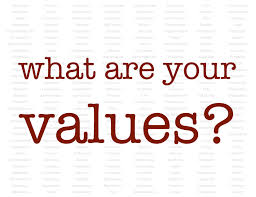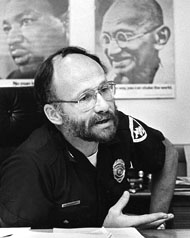What do you stand for as a leader?
(What’s that old adage: “If we don’t stand for something, we will fall for anything?”)
Values count. What you, as a leader, talk about, and do, matters.
Our values influence the decisions we make and how we act.
When was the last time you outlined the core values your organization and how its employees should act?
In short, what is your department’s value statement?
And your personal and professional value set?
I have two leadership assignments for you:
- The next time you are asked to give a talk to one of your local service clubs, talk about your values — how they have influenced you in your career, how they influence the decisions you make, the people you hire and how they are trained.
- Then do it at a roll call or other rank and file employee meeting.
As a leader, there should be no doubt among those you are privileged to lead (and the members of your community) as to where you stand.
If there is, start defining, firming up, acting and verbally defining what you value.
For example, the following comes from early in my career in Madison. These are the things I talked about when I attended shift roll calls as well as community meetings.
+++++++++++++
“In most professional organizations, training and education is central to who they are. This is accomplished by closely working with academic institutions and training academies, and maintaining high standards for recognition and accreditation in a particular field. A profession’s key values are also usually highly publicized and known by those whom they serve; e.g. a physician’s commitment to do no harm. This can be accomplished through something as simple as a short statement about the way the work should be practiced, how people ought to be treated, and how new ideas and challenges should be approached and responded to…
“The challenge to police today, if policing is ever going to be considered a profession is rather clear: they will need to develop a system of sustained leadership along with a body of knowledge that is able to fluidly incorporate research findings, be willing to experiment with this new knowledge, and effectively turn it into field practices. This is what professionals do. Thus, every police officer trained anywhere in the country would learn tried and tested methods, best practices and, in turn, would be expected to practice them during his or her career.
“My point is, police leaders have a critical role to play in this society as guardians of our rights. This must never be forgotten by them or by us. Until American police forge and claim that unique role in our society, they will continue to be viewed in the dim light of the past—as somehow being an ongoing part of the problematic historical legacy that I outlined earlier. For without a commitment to, and practice of, the values I have emphasized in this book, police will continue to be bogged down by a combination of poor performance and low expectations from the public. And that is a tragic situation.
“From day one as a chief, I began to describe my expectations for the department at every opportunity. I was in the business of selling organizational change. I found that one of the top opportunities to do this was at the graduation of a class of new police officers. This was always a big event in Madison. I wanted my new officers to know who I was and what my expectations were—but most of all, how passionate I was about them.
- Employ your full skill at all times and to all persons.
- Prevent, manage, or intervene in situations requiring police service.
- Be open, accept change in this changing world, develop and maintain a broad perspective of your function and the society in which you work, be flexible and develop the ability to grow with the people you serve.
“Expectations [values] matter. I would continue to use the same set of expectations over my years in Madison because they were what I expected of myself and from every police officer with whom I worked. These expectations would be the foundation of the Madison Vision. But before my expectations became the driving vision for the Madison department, there was a lot of work that first needed to be done.
“If a vision is going to be sustainable and last beyond the leader who casts it, the process is as important as the product. First, police leaders are needed who are not only monomaniacs with a mission, but who are willing to stay around long enough and to suffer through the pain that inevitably comes with an organization in the process of change.
“Second, there needs to be constant and on-going support by the community including elected officials—those outside the organization—to help make the vision a reality. Leaders must cast their vision outside the department as much as they do inside of it.
“Third, those within the organization must know their leader is willing to engage in a process with them to develop the vision. They, too, must be willing to participate in the work to make the vision become a reality and do all that they can to operate under its direction.
“The Madison vision statement gained more traction within the department as each class of new officers took to the street. Time was on my side. And working closely with members of the department, I began to develop, with them, a more formal vision and mission statement that reflected the values that I sensed we all were beginning to share. The vision and mission statements brought out in 1986 had that support. It defined who we were, what we wished to become, and what our citizens deserved. It laid the groundwork for even bolder steps ahead.
THE MADISON POLICE DEPARTMENT
VISION
We are a dynamic organization devoted to improvement, excellence, maintaining customer satisfaction, and operating on the principles of quality leadership.
“Closer to the People; Quality from the Inside Out”
MISSION
We believe in the dignity and worth of all people.
We are committed to: providing high-quality, community-oriented police services with sensitivity, protecting constitutional rights, problem-solving, teamwork, openness, planning for the future, continuous improvement, and providing leadership to the police profession.
We are proud of the diversity of our work force, which permits us to grow and which respects each of us as individuals, and we strive for a healthful workplace.
(1986)
“A leader must be able to encourage and enlist a substantial cadre of supporters within the organization, both junior and senior, who will stand up, move out, and help make their leader’s vision their vision. Unless that happens, a vision will never become a reality…
“In Madison, a major amount of my time was spent establishing the value of an operating vision and the steps needed to make it happen—that is, its mission. The process of doing so is called catch-ball. The term comes from the quality improvement days of Deming. The leader is to form a vision and pass it to members throughout the organization. They look at it, consider it, talk about it, and bounce it back. The leader receives their input. They may even have added new ideas and information. The leader ponders and incorporates their feedback, and passes it back again. And so it goes until the vision becomes shared. This is an effective organizational technique in which not only visions, but also ideas and methods, can be passed back and forth within the hierarchy of the organization with the purpose of developing shared visions, ideas, and methods.
“I continued to promote my vision whenever I had the opportunity. As chief, I was in the sales business. And selling involves knowing your product and what your customers need. But if you don’t have a desired product, no matter how hard you sell, buyers will be few.” [From “Arrested Development: A Veteran Police Chief Sounds Off…“]
+++++++++++++
LEADERS:
- DEFINE YOUR VALUES,
- CAST YOUR VISION,
- KEEP IT ALWAYS IN FRONT AND
- CONTINUOUSLY PREACH IT!
You may also want to do the vision and values exercises in “The New Quality Leadership Workbook.”


• We believe our integrity is not negotiable.
• We believe we are individually accountable
for upholding the values of our organization.
• We believe we can best earn respect
by first respecting the rights of others.
• We believe in striving to achieve the highest
moral, ethical and professional standards.
• We believe partnerships built upon trust and communication today
will prepare us for tomorrow’s challenges
• We believe in providing exceptional service to our customers,
the citizens we serve.
LikeLike
Yup. This is what I am talking about. I am in no doubt that Chief Masterson has engaged in the important task of “catch-balling” these values with his officers and “preaching them on the circuit!” This is what they stand for!
LikeLike
The California Department of Corrections has something similar to Chief Mike Masterson’s statement; however, it doesn’t mean a thing because the leadership from the highest level down to the lowest supervisory level in both the custody and non-custody areas don’t believe in it at all and just about everyone (custody and non-custody) are backstabbing each other.
LikeLike
You’re right, Gunther, just because we say we believe in something doesn’t make it happen. As I learned from my quality improvement days, the quality of a product or service is determined by those on the receiving end — not those who provide the product or service. The question is “Does a person or organization ‘walk their talk?'”
LikeLike
Spot on with this write-up, I seriously believe that this site
needs much more attention. I’ll probably be back again to read more, thanks for the information!
LikeLike